Practicing the CBSE Sample Papers for Class 10 Maths Basic Set 10 allows you to get rid of exam fear and be confident to appear for the exam.
CBSE Sample Papers for Class 10 Maths Basic Set 10 with Solutions
Time Allowed : 3 hours
Maximum Marks : 80
General Instructions:
- This Question Paper has 5 Sections A, B, C, D, and E.
- Section A has 20 Multiple Choice Questions (MCQs) carrying 1 mark each.
- Section B has 5 Short Answer-I (SA-I) type questions carrying 2 marks each.
- Section C has 6 Short Answer-Il (SA-II) type questions carrying 3 marks each.
- Section D has 4 Long Answer (LA) type questions carrying 5 marks each.
- Section E has 3 Case Based integrated units of assessment (4 marks each) with sub-parts of the values of 1,1 and 2 marks each respectively.
- All Questions are compulsory. However, an internal choice in 2 Qs of 2 marks, 2 Qs of 3 marks and 2 Questions of 5 marks has been provided. An internal choice has been provided in the 2 marks questions of Section E.
- Draw neat figures wherever required. Take n = \(\frac{22}{7}\) wherever required if not stated.
Section – A
(Section A consists of 20 Questions of 1 marks each.)
Question 1.
A number is selected at random from the numbers 1 to 30. The probability that it is .a prime number is : [1]
(A) 3
(B) 6
(C) 3
(D) 30
Answer:
(C) 3
Explanation:
n(S) = 30
Let event A be prime numbers in 1 to 30
i. e., A =2, 3, 5, 7, 11, 13, 17, 19, 23, 29
n(A) = 10
p(A) = \(\frac{n(A)}{n(S)}\) = \(\frac{10}{30}\) = \(\frac{1}{3}\)
Question 2.
During conversion of a solid from one shape to another, the volume of new shape will: [1]
(A) increase
(B) decrease
(C) remains unaltered
(D) be doubled
Answer:
(C) remains unaltered
Explanation:
During reshaping a solid, the volume of new solid will be equal to old one or remains unaltered.
![]()
Question 3.
The diameter of a circle whose area is equal to the sum of the areas of the two circles of radii 3 cm and 4 cm is : [1]
(A) 11 cm
(B) 15 cm
(C) 12 cm
(D) 10 cm
Answer:
(D) 10 cm
Explanation:
Let r1 = 3 cm and r2 = 4 cm
Area of first circle = nr12 = π(3)2 = 9π cm2
Area of second circle =nr22 = π(4)2 = 16π cm2
According to question,
Area of circle = Area of first circle + Area of second circle
πR2 = 9π + 16π [where, R be radius of circle]
R2 = 25 ⇒ R = 5 cm
Diameter of a circle = 2R = 2 × 5 = 10 cm
Question 4.
If sin A = \(\frac{1}{2}\) then the value of cot A is : [1]
(A) \(\sqrt{3}\)
(B) \(\frac{1}{\sqrt{3}}\)
(C) \(\frac{\sqrt{3}}{2}\)
(D) 1
Answer:
(A) \(\sqrt{3}\)
Explanation:
Given, sin A = \(\frac{1}{2}\)
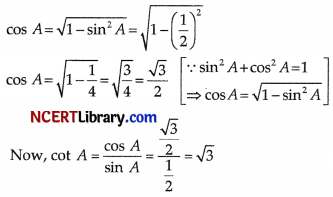
5. From a point Q, the length of the tangent to a circle is 24 cm and the distance of Q from the centre is 25 cm. The radius of the circle is : [1]
(A) 7 cm
(B) 12 cm
(C) 15 cm
(D) 24.5 cm
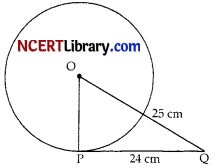
Answer:
(A) 7 cm
Explanation:
Let O be the centre of the circle.
Given that, OQ = 25 cm and PQ = 24 cm
We know that the radius is perpendicular to the tangent at the point of contact,
∴ OP ⊥ PQ
In ∆OPQ, we have By Pythagoras theorem,
OP2 + PQ2 = OQ2
OP2 + 242 = 252
OP2 + 576 = 625
OP2 = 625 – 576
OP2 = 49
OP = 7 cm
Therefore, the radius of the circle is 7 cm.
![]()
Question 6.
In fig., the distance of BC is:
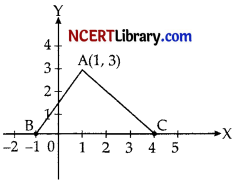
(A) 6 units
(B) 7 units
(C) 5 units
(D) 8 units
Answer:
(C) 5 units
Explanation:
Triangle formed by the given points A(1, 3), B(-1, 0) and C(4, 0).
∴ The distance of BC =\(\sqrt{(4 +1)^2 + (0-0)^2}\)
= \(\sqrt{(5)^2 + (0)^2}\)
= \(\sqrt{25}\)
= 5 units
Question 7.
The famous mathematician associated with finding the sum of the first 100 natural numbers is : [1]
(A) Pythagoras
(B) Newton
(C) Gauss
(D) Euclid
Answer:
(C) Gauss
Explanation :
The famous mathematician associated with finding the sum of the first 100 natural numbers is Gauss.
Question 8.
The quadratic equation 2x2 – 5x + 1 = 0 has [1]
(A) two distinct real roots
(B) two equal real roots
(C) no real roots
(D) more than 2 real roots
Answer:
(C) no real roots
Explanation:
2x2 – \(\sqrt{5}\)x + 1 = 0
On comparing with ax2 +bx +c =0
a = 2, b = –\(\sqrt{5}\), c = 1
Discriminant = b2 – 4ac =(-\(\sqrt{5}\))2 – 4(2)(1)
= 5 – 8 = -3 < 0
Therefore, the equation has no real roots.
![]()
Question 9.
n2 – 1 is divisible by 8, if n is : [1]
(A) an integer.
(B) a natural number.
(C) an odd integer.
(D) an even integer.
Answer:
(C) an odd integer.
Explanation:
Any odd integer can be written as 2m + 1.
Put n = 2m + 1 in n2 – 1
n2 -1 = (n + 1)(n – 1)
= (2m + 2)(2m) = 4m(m + l)
The product of two consecutive numbers is divisible by 2.
Thus, m(m + 1) is divisible by 2. Let m(m + 1) = 2k
n2 -1 = (n +1 )(n -1) = (2m + 2)(2m)
= 4 m(m +1) = 4 × 2k = 8k
Thus, if n is an odd integer then n2 – 1 is divisible by 8.
Question 10.
While computing mean of grouped data, we assume that the frequencies are:
(A) evenly distributed over all the classes
(B) centred at the class marks of the classes
(C) centred at the upper limits ofthe classes
(D) centred at the lower limits of the classes
Answer:
(B) centred at the class marks of the classes
Explanation:
In grouping the data from ungrouped data, all the observations between lower and upper limits of class marks are taken in one group then mid-value or class mark is taken for further calculation.
Therefore, frequencies or observations must be centred at the class marks of the classes.
Question 11.
1245 is a factor of the numbers p and q.
Which of the following will always have 1245 as a factor?
(i) p + q
(ii) p × q
(iii) p ÷ q
(A) only (ii)
(B) only (i) and (ii)
(C) only (ii) and (iii)
(D) all – (i), (ii) and (iii)
Answer:
(B) only (i) and (ii)
Explanation:
Given, 1245 is a factor of two numbers p and q.
p = 1245 A and q = 1245 B
Now, p + q = 1245 A + 1245 B = 1245 (A + B)
Hence, p + q have a factor 1245 always.
Now, p × q = 1245 A × 1245 B = (1245)² AB
Hence, p × q have a factor 1245 always.
Question 12.
Graphically, the pair of equations x = 9 and y = 17 represents two lines which are
(A) intersecting at (17,9)
(B) intersecting at (9,17)
(C) coincident
(D) parallel
Answer:
(B) intersecting at (9,17)
Explanation:
Given equations are x = 9, y = 17 in standard from x + 0. y – 9 = 0 and 0. x + y -17 = 0
\(\frac{a_1}{a_2}=\frac{1}{0}, \frac{b_1}{b_2}=\frac{0}{1}\)
and \(\frac{c_1}{c_2}=\frac{-9}{-17}=\frac{9}{17}\)
Since, \(\frac{a_1}{a_2} \neq \frac{b_1}{b_2}\)
Hence given lines are intersecting at x = 9, y = 17
i.e., (9, 17)
![]()
Question 13.
The co-ordinates of the point which is reflection of point (-3, 5) in x-axis are: [1]
(A) (3,5)
(B) (3, -5)
(C) (-3, -5)
(D) (-3,5)
Answer:
(C) (-3, -5)
Explanation:
By using the graph of coordinate plane, we have the reflection of point (- 3, 5) is x-axis is (-3,-5).

Question 14.
Savita has a lamp placed at the center of her square yard, each side measuring 20 m. The light of lamp covers a circle of radius 10 m on yard. What area of the yard is NOT lit by the lamp? [1]
(A) 400π sq. m
(B) 100π sq. m
(C) (40 – 10π) sq. m
(D) (400 – 100π) sq. m
Answer:
(D) (400 – 100π) sq. m
Explanation:
Each side of Savita’s square yard = 20 m
∴ Area of square yard = (side)²
= (20)² = 400 m²
Radius of circle, where light of lamp covers = 10 m
Area of circle = πr²
= π (10)² = 100π m2
Hence, the area of the yard is not lit by the lamp = Area of square yard
∴ Area of circle = (400 – 100π) m2
Question 15.
In triangles ABC and DEF, ∠B = ∠E, ∠E = ∠C and AB = 3DE. Then, the two triangles are: [1]
(A) congruent but not similar
(B) similar but not congruent
(C) neither congruent nor similar
(D) congruent as well as similar
Answer:
(B) similar but not congruent
Explanation: In ∠ABC and ∠DEF, ∠B = ∠E and ∠F = ∠C.
By AA similarity, we get ∠ABC ~ ∠DEF.
Thus, the triangles are similar but not congruent.
Question 16.
If a card is selected from a deck of 52 cards, then the probability of its being a black face card is : [1]
(A) \(\frac{3}{26}\)
(B) \(\frac{3}{13}\)
(C) \(\frac{2}{13}\)
(D) \(\frac{1}{2}\)
Answer:
(A) \(\frac{3}{26}\)
Explanation: In a deck of 52 cards, there are 26 red cards.
Number of black face cards = 6
So, probability of having a black face card
= \(\frac{6}{52}\) = \(\frac{3}{26}\).
![]()
Question 17.
A pole 6 m high casts a shadow 2\(\sqrt{3}\) m long on the ground, then the Sun’s elevation is: [1]
(A) 60°
(B) 45°
(C) 30°
(D) 90°
Answer:
(A) 60°
Explanation:
In ∆ABC, ∠B = 90°
tan θ = \(\frac{6}{2√3}\) = √3 = tan 60 ⇒ θ = 60°
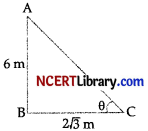
Question 18.
If in triangles ABC and DEF, = then they will be similar, when: [1]
(A) ∠B = ∠E
(B) ∠A = ∠D
(C) ∠B = ∠D
(D) ∠A = ∠F
Answer:
(C) ∠B = ∠D
Explanation :
In AABC and ADEF, we have
\(\frac{A B}{D E}=\frac{B C}{F D} \Rightarrow \frac{A B}{E D}=\frac{B C}{D F}\)
To be similar of AABC and ADEF,
we must have ∠B = ∠D.
Directions for questions 19 & 20: In the following questions, A statement of Assertion (A) is followed by a statement of Reason (R).
(A) Both (A) and (R) are true and (R) is the correct explanation of (A).
(B) Both (A) and (R) are true but (R) is NOT the correct explanation of (A).
(C) (A) is true but (R) is false.
(D) (A) is false and (R) is true.
Question 19.
Assertion (A): If the pair of linear equations 3x + y = 3 and 6x + ky = 8 does not have a solution, then the value of k = 2.
Reason (R): If the pair of linear equations x + y – 4 = 0 and 2x + ky = 3 does not have a solution, then the value of k = 2. [1]
Answer:
(B) Both (A) and (R) are true but (R) is NOT the correct explanation of (A).
Explanation:
In case of assertion:
Given equation are:
3x + y-3 =0 …(i)
and 6x + ky -8 =0 …(ii)
Comparing eq. (i) with a1x + b1y + c1 = 0 and eq. (ii) with a2x + b2y + c1 = 0, we get,
a1 = 3, a2 = 6, b1 = 1, b2 = k, c1 = – 3 and c2 = – 8
Since, given equations has no solution.
So, \(\frac{a_1}{a_2}=\frac{b_1}{b_2} \neq \frac{c_1}{c_2}\)
⇒ \(\frac{3}{6}=\frac{1}{k} \neq \frac{-3}{-8}\)
⇒ \(\frac{1}{2}=\frac{1}{k} \neq \frac{3}{8}\)
Either \(\frac{1}{2}\) = \(\frac{1}{k}\) or \(\frac{1}{k}\) ≠ \(\frac{3}{8}\)
⇒ k = 2 or k ≠ \(\frac{3}{8}\)
Hence, the value of k is 2.
Thus, assertion is correct.
In case of reason:
Given equations:
x + y – 4 = 0 and 2x + ky – 3 =0
Here \(\frac{a_1}{a_2}=\frac{1}{2}, \frac{b_1}{b_2}=\frac{1}{k} \)
and \(\frac{c_1}{c_2}=\frac{-4}{-3}=\frac{4}{3}\)
System has no solution.
\(\frac{a_1}{a_2}=\frac{b_1}{b_2} \neq \frac{c_1}{c_2}\)
⇒ \(\frac{1}{2}=\frac{1}{k} \neq \frac{4}{3}\)
⇒ k = 2 or k ≠ \(\frac{3}{4}\)
Hence, the value of k is 2.
Thus, reason is correct.
Hence, both assertion and reason are correct but reason is not the correct explanation for assertion.
![]()
Question 20.
Assertion (A): Every quadratic equation has exactly one root.
Reason (R): Every quadratic equation has almost two roots. [1]
Answer:
(D) (A) is false and (R) is true.
Explanation:
In case of assertion:
Since, a quadratic equation has two and only two roots.
∴ Assertion is incorrect.
In case of reason:
Because every quadratic polynomial has almost two roots.
∴ Reason is correct.
Hence, assertion is incorrect but reason is correct.
Section – B
(Section B consists of 5 Questions of 2 marks each.)
Question 21 .
In fig., sectors of two concentric circles of radii 7 cm and 3.5 cm are given. Find the area of shaded region.
(Use π = \(\frac{22}{7}\))
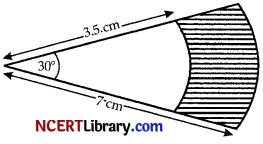
Answer:
Area of large circle = π(7)²
Area of small circle = π(\(\frac{7}{2}\))²
Required area of sector = area of large sector – area of small sector
= \(\frac{30^{\circ}}{360^{\circ}} \times \pi\left(7^2-\frac{7}{2}\right)^2\)
= \(\frac{1}{12} \times \pi \times\left(49-\frac{49}{4}\right)\)
= 9.6 cm²
Question 22.
In ∆ABC,DE || BC, find the value of x.
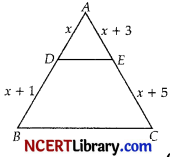
OR
In the given figure, PQ and PR are tangents to the circle with centre O such that ∠QPR = 60°, then find ∠OQR.
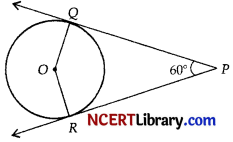
Answer:
DE || BC
\(\frac{A D}{D B}=\frac{A E}{E C}\)
or, \(\frac{x}{x+1}=\frac{x+3}{x+5}\)
or, x² + 5x = x² + 4x + 3
or, x =3
OR
∠QPR = 60° (Given)
∠QOR + ∠QPR = 180° (Supplementary angels)
∠QOR = 180° – 60° = 120°
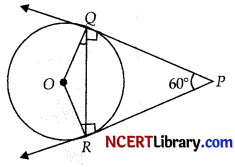
From OQR
or, ∠QOR = ∠ORQ = \(\frac{120°}{2}\)
= 60°
![]()
Question 23.
The diameter of a wheel is 1.26 m. What is the distance covered in 500 revolutions ?
Answer:
Distance covered in 1 revolution = circumference of wheel
= πd
= π × 1.26 m
Distance covered in 500 revolutions = 500 × π × 1.26
= 500 × \(\frac{22}{7}\) × 1.26
= 1980 m = 1.98 km
Question 24.
Prove that: \(\sqrt{\frac{1-cos A}{1+cos A}}=cosec A-cot A\)
Answer:
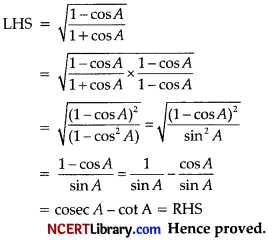
Question 25.
Two tangents TP and TQ are drawn to a circle with centre O from an external point T. Prove that ∠PTQ = 2∠OPQ
OR
The perpendicular AD on the base BC of a ∆ABC intersects BC at D so that DB = 3CD.
Prove that 2(AB)² = 2(AC)² + BC².
Answer:
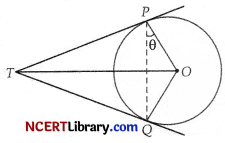
Let ∠OPQ be θ.
∴ ∠TPQ = (90° – 0)
Since TP = TQ (Tangents)
∠TQP = (90° – 0) (Opposite angles of equal sides)
Now, ∠TPQ + ∠TQP + ∠PTQ = 180°
⇒ 90° – 0 + 90°-0 ∠PTQ = 180°
⇒ ∠PTQ = 180° -180° + 20
⇒ ∠PTQ = 20
⇒ ∠PTQ = 2 ∠OPQ.
OR
In ∆ADB, AB² = AD² + BD² ……(i)
(Pythagoras Theorem)
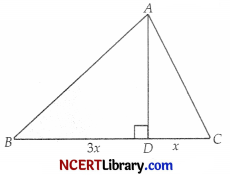
In ∆ADC, AC² = AD² + CD² ……(ii)
(Pythagoras Theorem)
Subtracting eqn. (ii) from eqn. (i),
AB² – AC² = B – CD²
or, (\(\frac{3}{4}\)BC)² – (\(\frac{1}{4}\)BC)²
or, \(\frac{9}{16}\)BC² – \(\frac{1}{16}\)BC²
= \(\frac{BC^2}{2}\)
∴ 2(AB² AC²) = BC²
∴ 2(AB)² = 2AC² + BC²
Hence Proved.
![]()
Section – C
(Section C consists of 6 Questions of 3 marks each.)
Question 26.
Given that \(\sqrt{3}\) is an irrational number, show that (5 + 2\(\sqrt{3}\)) is an irrational number. [3]
Answer:
Let us assume (5 + 2\(\sqrt{3}\)) is a rational number.
∴ 5 + 2\(\sqrt{3}\) = \(\frac{p}{q}\)
(where, q ≠0 and p and q are co prime integers)
⇒ \(\sqrt{3}\) = \(\frac{p-5q}{2q}\)
This contradicts the given fact that \(\sqrt{3}\) is irrational.
Hence, (5 + 2\(\sqrt{3}\)) is an irrational number.
Question 27.
Find the roots of the following quadratic equation: 15x² – 10\(\sqrt{6}\) x + 10 = 0 [3]
Answer:
Given,
15x² – 10\(\sqrt{6}\) x + 10 = 0
⇒ 3x²-2\(\sqrt{6}\) + 2 =0
⇒ 3x² – \(\sqrt{6}\) x – \(\sqrt{6}\) x + 2 = 0
⇒ \(\sqrt{3}\)x(\(\sqrt{3}\)x- \(\sqrt{2}\))- \(\sqrt{2}\)(\(\sqrt{3}\) – \(\sqrt{2}\)) = o
(\(\sqrt{3}\)x — \(\sqrt{2}\))( \(\sqrt{3}\)x – \(\sqrt{2}\)) = o
x = \(\frac{\sqrt{2}}{\sqrt{3}} \text { or } \frac{\sqrt{2}}{\sqrt{3}}\)
x = \(\frac{\sqrt{2}}{\sqrt{3}}, \frac{\sqrt{2}}{\sqrt{3}}\)
Question 28.
Find the value of k, if -1 is a zero of the polynomial p(x) = kx² – 4x + k. [3]
OR
The incomes of two persons A and B are in the ratio 8 : 7 and the ratio of their expenditures is 19 :16. If their savings are ₹ 2550 per month, find their monthly income.
Answer:
Since, -1 is a zero of the polynomial and p(x) = kx² – 4x + k,
then p(-1) = 0
k(-1)² – 4(-1) + k = 0
⇒ k + 4 + k = 0
⇒ 2k + 4 = 0
⇒ 2k = -4
Hence, k = -2
OR
Let income of A = 8x and
income of B = 7x
Also their expenditures be 19y and 16y.
⇒ 8x – 19y = 2550 ……..(i)
and 7x – 16y = 2550 ………(ii)
Solving the equations
x = 1530 and y = 510
∴ Salary of A = 12240
Salary of B = 10710
Question 29.
A bag contains 5 red balls and some blue balls. If the probability of drawing a blue ball from the bag is thrice that of the red ball, find the number of blue balls in the bag. [3]
Answer:
Let Blue balls = x and red balls = 5
∴ Total balls = 5 + x
P(red balls) = \(\frac{5}{5+x}\)
P(blue balls) = \(\frac{x}{5+x}\)
Given, \(\frac{x}{5+x}\) = 3\(\frac{5}{5+x}\)
⇒ x = 15
![]()
Question 30.
Find a quadratic polynomial, whose zeroes are -3 and 4. [3]
OR
Two lines are given to be parallel. The equation of one of the lines is 4x + 3y = 14, then find the equation of a second line.
Answer:
The quadratic polynomial having roots α and ß is x² – (α + ß) + αß.
Here, roots of the quadratic polynomial are given as -3 and 4.
∴ Sum of the roots = -3 + 4 = 1
and Product of the roots = -3 × 4 = -12
∴ The quadratic polynomial is = x² – (α + ß)x + αß
= x² – 1x -12
Hence the required polynomial is x² – x – 12.
OR
The equation of one line is 4x + 3y = 14.
We know that if two lines a1x + b1y + c1x = 0 and a2x + b2y + c1 = 0 are parallel, then
\(\frac{a_1}{a_2}=\frac{b_1}{b_2} \neq \frac{c_1}{c_2}\)
or \(\frac{4}{a_2}=\frac{3}{b_2} \neq \frac{-14}{c_2}\)
⇒ \(\frac{a_2}{b_2}=\frac{4}{3}=\frac{12}{9}\)
Hence, one of the possible, second parallel line is 12x + 9y = 5.
Question 31.
In a single throw of a pair of different dice, what is the probability of getting
(i) a prime number on each dice ?
(ii) a total of 9 or 11 ? [3]
Answer:
(i) Favourable outcomes are (2, 2) (2, 3) (2,5) (3,2) (3, 3) (3,5) (5,2) (5, 3) (5,5) i.e., 9 outcomes.
P (a prime number on each die) = \(\frac{9}{36}\) or \(\frac{1}{4}\)
(ii) Favourable outcomes are (3, 6) (4, 5) (5, 4) (6, 3) (5,6) (6,5) i.e., 6 outcomes
P (a total of 9 or 11) = \(\frac{6}{36}\) or \(\frac{1}{6}\)
Section – D
(Section D consists of 4 Questions of 5 marks each.)
Question 32.
The angle of depression of two ships from an aeroplane flying at the height of 7500 m are 30° and 45°. If both the ships are in the same line that one ship is exactly behind the other, find the distance between the ships. [5]
OR
The angle of elevation of the top Q of a vertical tower PQ from a point X on the ground is 60°. From a point Y, 40 m vertically above X, the angle of elevation of the top Q of tower is 45°. Find the height of the tower PQ and the distance PX. (Use π = 1.73)
Answer:
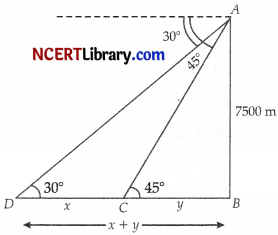
In ∆ABC,
\(\frac{A B}{B C}\) = tan 45°
\(\frac{7500}{y}\) = 1
y = 7500
In ∆ABD,
\(\frac{A B}{B D}\) = tan 30°
\(\frac{7500}{x+y}\) = \(\frac{1}{\sqrt{3}}\)
x + y = 7500\(\sqrt{3}\)
x + 7500 = 7500\(\sqrt{3}\)
x = 7500\(\sqrt{3}\) – 7500
= 7500(\(\sqrt{3}\) – 1)
= 7500(1.73 – 1)
= 7500 × 0.73
= 5475 m
Hence, the distance between two ships = 5475 m
OR
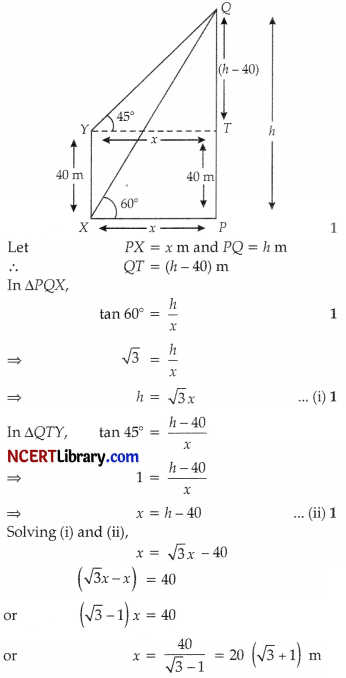
∴ h = \(\sqrt{3}\) × 20(\(\sqrt{3}\) + 1) = 20(3 + \(\sqrt{3}\))
20(3 + 1.73) = 20 × 4.73
Hence, the height of tower is 94.6 m.
![]()
Question 33.
a, b and c are the sides of a right triangle, where c is the hypotenuse. A circle, of radius r, touches the sides of the triangle. Prove that r = \(\frac{a+b-c}{2}\)
Answer:
Let circle touches CB at M, CA at N and AB at P.
Now, OM ⊥ CB and ON ⊥ AC.
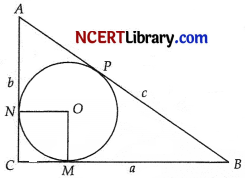
(radius ⊥ tangent)
OM = ON
CM = CN
OMCN is a square.
Let OM = r = CM = CN
AN = AP, CN = CM and BM = BP
(tangent from external point)
AN = AP
⇒ AC – CN = AB – BP
b – r = c – BM
b – r = c – (a- r)
b – r = c – a + r
∴ 2r = a + b – c
r = \(\frac{a+b-c}{2}\)
Hence Proved.
Question 34.
Find the area of the shaded region in figure, \(\widehat{A P D}\), \(\widehat{A Q B}\), \(\widehat{B R C}\) and \(\widehat{C S D}\), are semi-circles of diameter 14 cm, 3.5 cm, 7 cm and 3.5 cm respectively. (Use π = \(\frac{22}{7}\)).
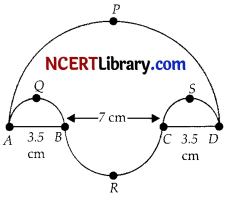
OR
The internal and external diameters of a hollow hemispherical vessel are 16 cm and 12 cm respectively. If the cost of painting 1 cm2 of the surface area is ₹ 5.00, find the total cost of painting the vessel all over. (Use π = 3.14)
Answer:
Area of shaded region
ar (BRC) -ar (A QB) -ar (CSD) + ar (APD)
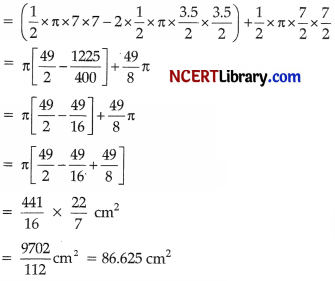
OR
R = 8 cm, r = 6 cm
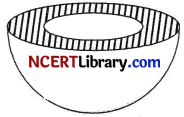
Total Surface area = 2πR² + 2πr² + π(R² – r²)
= π[8² × 2 + 6² × 2 + (8² – 6²)]
= π [64 × 2 + 36 × 2 + (64 – 36)]
= π[128 + 72 + 28]
= 228 π cm²
= 228 × 3.14
= 715.92 cm²
Total cost of painting = ₹ 715.92 × 5 = ₹ 3579.60
Question 35.
The mean of the following distribution is 31.4. Determine the missing frequency x.
| Class | 0-10 | 10-20 | 20-30 | 30-40 | 40-50 | 50-60 |
| Frequency | 5 | x | 10 | 12 | 7 | 8 |
Answer:
| C.I. | xi | fi | \(u_i=\frac{x_i-a}{h}\) | fiui |
| 0-10 | 5 | 5 | -3 | -5 |
| 10-20 | 15 | x | -2 | -x |
| 20-30 | 25 | 10 | -1 | -10 |
| 30-40 | 35 = a | 12 | 0 | 0 |
| 40-50 | 45 | 7 | 1 | 7 |
| 50-60 | 55 | 8 | 2 | 16 |
| Total | 42 + x | – 2x -2 |
a = Assumed mean
= mid point of class 30 – 40 = 35
Mean = \(a+\frac{\Sigma f_i u_i}{\Sigma f_i} \times h\)
= \(35+\frac{-2x-2}{42+x} \times 10\)
⇒ (2x + 2)10 = (42 + x)(3.6)
⇒ 20x + 20 = 151.2 + 3.6x
⇒ 16.4x = 131.2
∴ x = 8
![]()
Section – E
(Case study based questions are compulsory.)
Question 36.
Ayush Starts walking from his house to office. Instead of going to the office directly he goes to a bank first, from there to his daughter’s school and then reaches the office.
(Assume that all distances covered are in straight lines). If the house is situated at (2,4), bank at (5,8), school at (13, 14) and office at (13,26) and coordinates are in km.
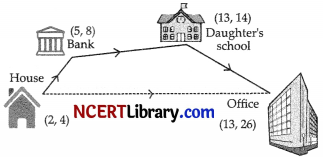
I. What is the distance between house and bank? [1]
II. What is the distance between daughter’s school and bank? [1]
III. What is the distance between house and office? [2]
OR
What is the total distance travelled by Ayush to reach the office?
Answer:
I. We know that,
Distance between two points (x1, y1) and (x2, y2)
d= |}\(\sqrt{\left(x_2-x_1\right)^2+\left(y_2-y_1\right)^2}\)|
Now, distance between house and bank,
= |\(\sqrt{(5-2)^2+(8-4)^2}\)|
= |\(\sqrt{(3)^2+(4)^2}\)|
= |\(\sqrt{9 + 16}\)|
= |\(\sqrt{25}\)|
= 5 km
II. Distance between bank and daughter’s school,
= |\(\sqrt{(13-5)^2+(14-8)^2}\)|
= |\(\sqrt{(8)^2+(6)^2}\)|
= |\(\sqrt{64 + 36}\)|
= |\(\sqrt{100}\)|
= 10 km
III. Distance between daughter’s school and office,
= |\(\sqrt{(13-2)^2 +(26-4)^2}\)|
= |\(\sqrt{(11)^2 +(22)^2}\)|
= |\(\sqrt{121 + 484}\)|
= |\(\sqrt{605}\)|
= 24.59
= 24.6 km
OR
Distance between daughter’s school and office,
= |\(\sqrt{(13 -13)^2 + (26 -14)^2}\)|
= |\(\sqrt{0+(12)^2}\)|
= 12 km
Total distance (House + Bank + School + Office) travelled = 5 + 10 + 12 = 27 km
![]()
Question 37.
Your friend Veer wants to participate in a 200 m race. He can currently run that distance in 51 seconds and with each day of practice it takes him 2 seconds less. He wants to do in 31 seconds.

I. Form A.E for the given situation. [1]
II. What is the minimum number of days he needs to practice till his goal is achieved ? [1]
III. If nth term of an A.E is given by an = 2n + 3, then find the common difference of A.E [2]
OR
Find the value of x, for which 2x, x + 10, 3x + 2 are three consecutive terms of an A.E
Answer:
I. a = 51
d = – 2
AP = 51,49,47……
II. Goal = 31 second
n = number of days
∴ an = 31
a + (n – 1 )d = 31
51 + (n – 1)(n – 2) = 31
51 – 2n + 2 = 31
-2n = 31 – 53
-2n = – 22
n = 11
III. an = 2n + 3 (given)
a1 = 2 × 1 + 3 = 5
a2 = 2 × 2 + 3 = 7
a3 = 2 × 3 + 3 = 9
So, common difference = a2 – a1 = 7 – 5
= 2
OR
Since, 2x, x + 10, 3x + 2 are in A.R, this common difference will remain same.
x + 10 – 2x = (3x + 2) – (x + 10)
10 – x = 2x – 8
3x = 18
x = 6
![]()
Question 38.
A satellite flying at height h is watching the top of the two tallest mountains in Uttarakhand and Karnataka, them being Nanda Devi (height 7,816 m) and Mullayanagiri (height 1,930 m). The angles of depression from the satellite, to the top of Nanda Devi and Mullayanagiri are 30° and 60° respectively. If the distance between the peaks of two mountains is 1937 km, and the satellite is vertically above the midpoint of the distance between the two mountains.
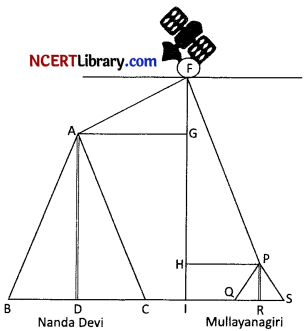
I. What is the distance of the satellite from the top of Nanda Devi. [2]
OR
What is the distance of the satellite from the top of Mullayanagiri.
II. What is the angle of elevation if a man is standing at a distance of 7816 m from Nanda Devi ? [1]
III. If a mile stone very far away from, makes 45° to the top of Mullanyangiri mountain. So, find the distance of this mile stone from the mountain. [1]
Answer:
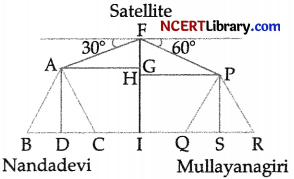
Now, AG = \(\frac{1937}{2}\) km
cos θ = \(\frac{AG}{AF}\)
cos 60° = \(\frac{\frac{1937}{2}}{AF}\)
\(\frac{\sqrt{3}}{2}\) = \(\frac{1937}{2AF}\)
AF = \(\frac{1937}{\sqrt{3}}\)
AF = 1118.36 km
OR
For ∆FPH,
cos θ = \(\frac{PH}{FP}\)
cos 60° = \(\frac{1937}{2FP}\)
\(\frac{1}{2}\) = \(\frac{1937}{2AF}\)
FP = 1937 km
II. Height of Nanda Devi Mountain = 7816 m
Distance between man and mountain = 7816 m
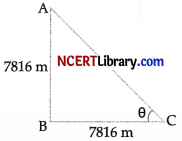
tan θ = \(\frac{AB}{BC}\)
tan θ = \(\frac{7816}{7816}\)
tan θ = 1
tan θ = tan 45°
θ = 45°
III. Height of Mullanyangiri = 1937 m
The mile stone makes the 45° to top of Mullanyangiri.
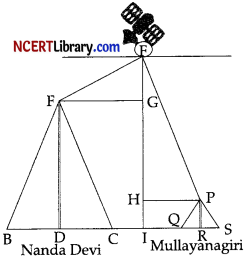
In ∆ABC,
tan 45° = \(\frac{AB}{CB}\)
1 = \(\frac{1937}{CB}\)
CB = 1937 m
So, distance of mile stone Mullanyangiri.